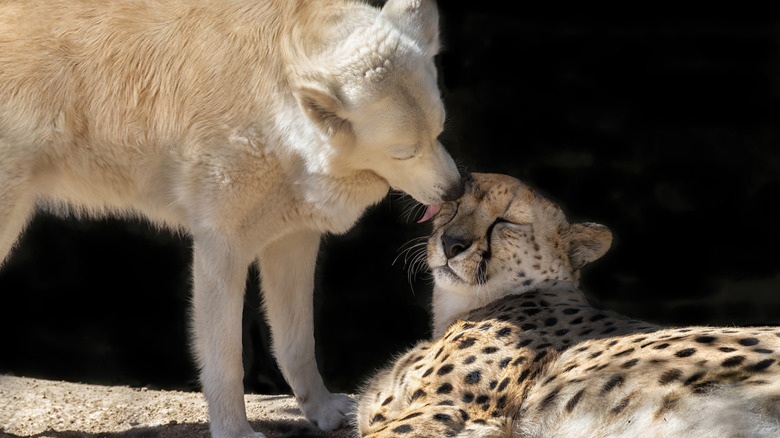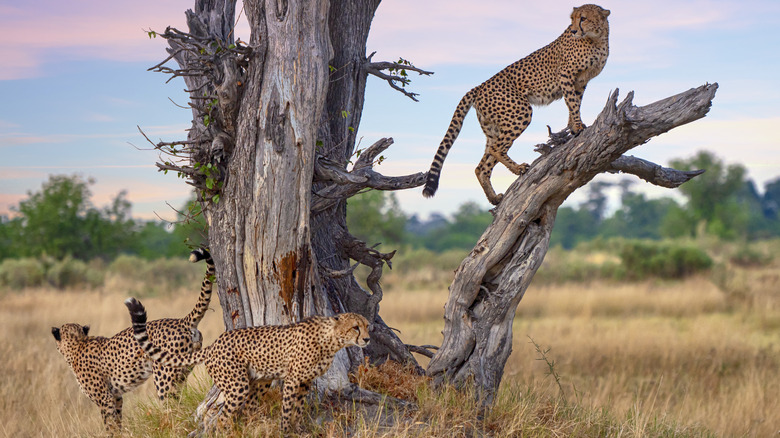Why Cheetahs At Zoos Sometimes Have Support Dogs
Many dogs are known for their caring personas, providing support to their human counterparts in many ways. This attentive nature and kindness have enabled canines to become integral in many people's lives, taking on roles such as emotional support, therapy, or service dogs. In fact, an estimated 500,000 dogs work with people in need. Using this unique skillset, some dogs have gone above and beyond in providing support to other animals, with zoos pairing shy cheetahs with loving canine companions.
The practice began in 1976, when conservation biologist Dr. Laurie Marker cared for a lone cheetah cub as part a wildlife safari's breeding program. To help the cub adapt to its new environment, she had the idea to pair it with a dog. Speaking to Atlas Obscura, Marker explained how the bond worked, saying, "Companion dogs act as a surrogate for cheetah siblings," adding, "It is the friendship between the two individuals that creates a strong bond, and this is what makes for a successful pairing." Since then, the San Diego Zoo has become exemplary in showcasing the rehabilitative effects of the adorable duo, with several successful friendships starting in the 1980s.
@ryan.slasher Wildlife Wonders, FREE 2pm show at the San Diego Zoo!! It is a different show every single day!! #sandiegozoo #SanDiego #zoo #sunnyday #funday #ryanslasher #awesome #FYI #dog #cheetah #zooguy
Since Marker's efforts to help abandoned or orphaned cubs, this practice has become common at zoos worldwide. In the above video, you can see a recent pairing at the San Diego Zoo featuring a cheetah and a golden retriever named Elvis. Golden retrievers, known for being a loving dog breed that knows when we're sad, make a common pairing for lonely cubs. While the interspecies friendship is pure and adorable, dogs can also play a significant role in the conservation efforts for the vulnerable cheetah.
How dogs help protect vulnerable cheetahs in the wild
The International Union for Conservation of Nature (IUCN) lists a declining population of mature cheetahs in the wild at 6,517 on its Red List. What's more, several cheetah species have gone extinct in certain regions, including India, Egypt, and Afghanistan. Namibia currently holds the largest population of wild cheetahs, but even then, current estimates only put numbers between 2,000 and 3,000 cats. However, like the supportive dogs in zoos, canines have been brought in to help cheetahs thrive.
In 2021, the Cheetah Conservation Fund (CCF) began training its first scat detection dog, a Belgian Malinois named Enyakwa (or Enya for short). Through extensive work, including positive reinforcement training, Enya can track cheetahs without the risks associated with human interaction. Enya also serves as an envoy for the CCF, helping to spread awareness about animal coexistence by visiting local areas with her trainer.
The CCF has another program that provides livestock-guarding dogs to farmers in Namibia. This program incentivizes farmers to protect their livestock from cheetahs and other predators. Positioned in areas where confrontations between cheetahs and livestock are most likely to occur, the dogs deter the big cats from attacking livestock. Safe livestock helps relationships between people and cheetahs, changing attitudes toward the big cat and preventing retaliatory killings. Ultimately, whether as companions in a zoo or assisting with conservation, the relationship between a cheetah and a dog can educate and inspire future generations to push for coexistence and protection.

